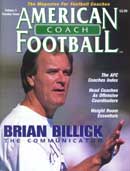AMERICAN FOOTBALL MONTHLY THE #1 RESOURCE FOR FOOTBALL COACHES
Article CategoriesAFM Magazine
|
Zone PressuresAttacking the Offense with Zone Conceptsby: David Wood Defensive Coordinator,Widener University © More from this issue *Photos/Diagrams are no longer available* The philosophy of our Zone Blitz Package at Widener is built upon the following concepts: simplicity, accountability and relentless pursuit to the football. Our package can be run with any of our defensive fronts, everywhere on the field and in all game situations. This allows us to give the offense a lot of different looks while maintaining our shell integrity in the secondary. As a result, we have a system that has multiple looks, is uncomplicated to learn, and looks the same to quarterbacks prior to the snap. (See Diagram 1) Two years ago we decided to go from a 4-3 to a 3-4 defense based on the personnel we were recruiting. The main goals of our zone blitz package are:
|
|
|||||||
| HOME |
MAGAZINE |
SUBSCRIBE | ONLINE COLUMNISTS | COACHING VIDEOS |
Copyright 2025, AmericanFootballMonthly.com
All Rights Reserved





